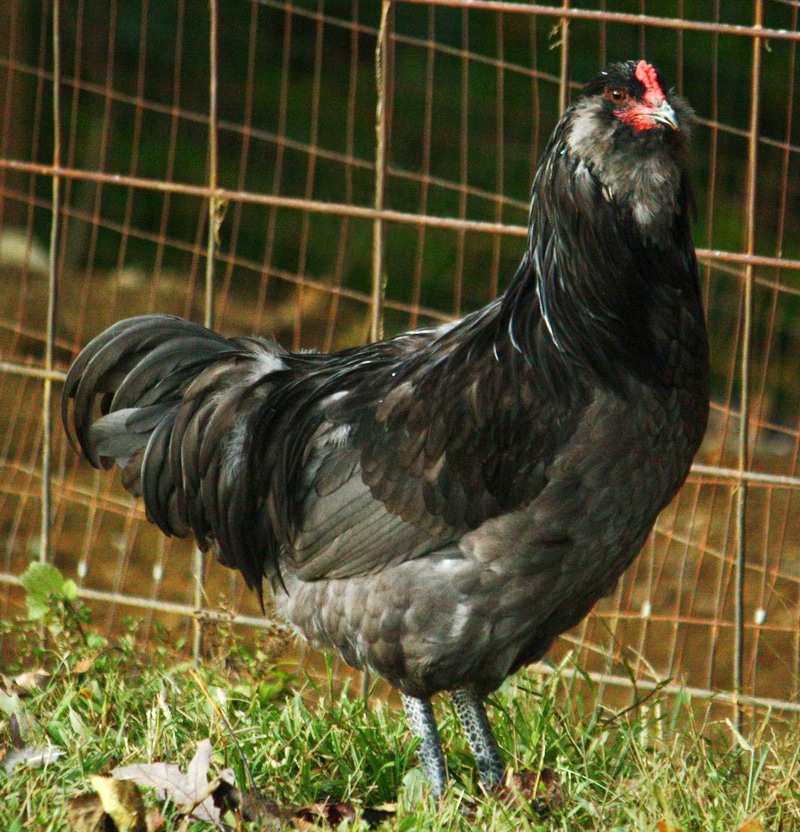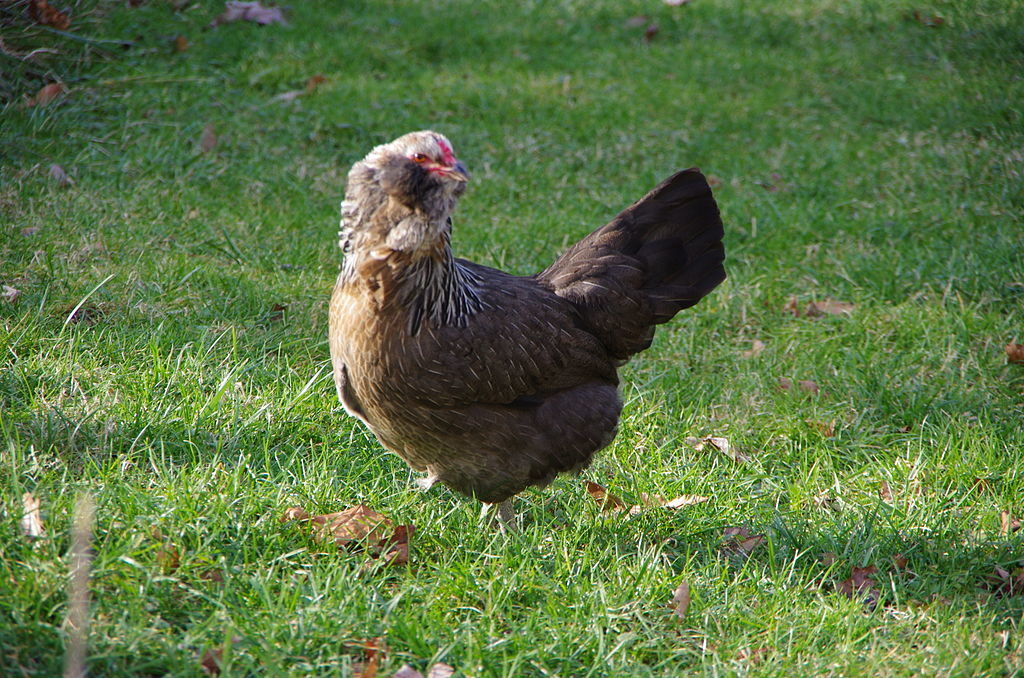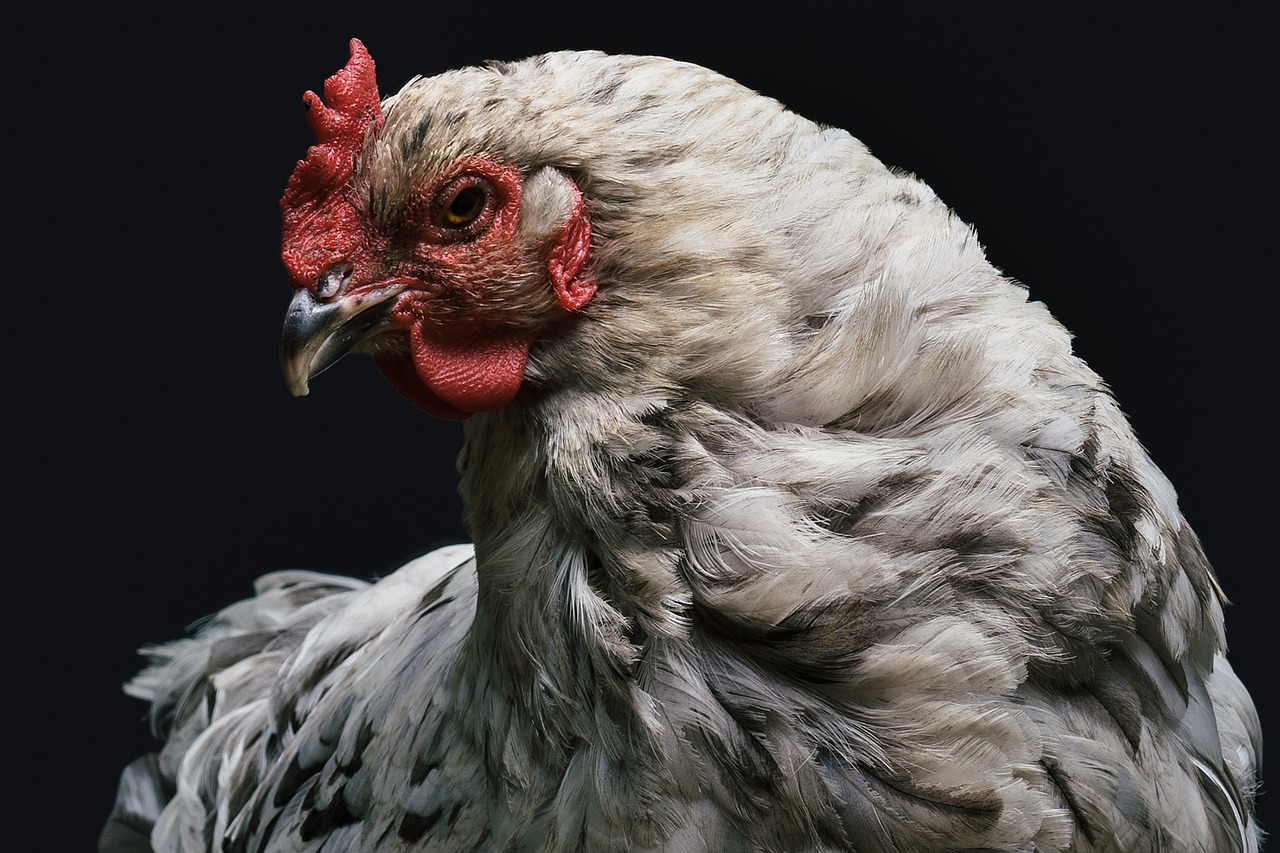Its name conjures up images of patriotism and regal displays of color. If you’ve ever seen some Ameraucana chickens, you would likely agree with this description.
This chicken breed, added to a lengthy list of recognized birds in the 1970s, is one of the most popular breeds in America – and it’s only getting more popular as time goes on.
The history of the Ameraucana chicken is colorful and storied – and its future is equally bright.
If you are interested in raising a backyard flock of chickens, you may want to consider the colorful and bold Ameraucana chicken breed – we’re here to tell you why.
Ameraucana Chickens Overview
Before we explore this breed’s traits, here’s an overview of what to expect.
| Lifespan | 7 to 8 years |
| Weight | 5.5 to 6.5 pounds |
| Appearance | Variety of color options with a muff and beard |
| Egg Production | About 200 per year |
| Egg Color | Blue |
| Good for Beginners? | Yes |
| Minimum Habitat Size | 4 square feet in the coop, 10 in the run |
| Price | $3 to $4 per chick |
History of the Ameraucana Chicken Breed

Accepted to the American Poultry Association In 1984, the Ameraucana is a recognized breed on its own, as is the bantam Ameraucana, which was accepted by the American Bantam Association in 1979.
Prior to that, the Ameraucana chicken first formally appeared in the 1920s in South America – however, it is believed to have been around for much longer.
The Mapuche Indians of Chile were known to keep two specific chicken breeds, the Quetero and the Collonca. These old chicken breeds had been around for practically forever, with documents citing their presence as early as the 1500s.
The Quetero and the Collonca were bred together (it’s unclear whether they joined as the result of natural forces or by human intervention) and after this partnering occurred, the Araucana resulted.
As you may or may not know, the Araucana is a parent bird of the Ameraucana. As you might imagine, Araucanas are extremely rare. The reason as to why lies in the breed’s genetics.
Araucanas have lethal genes that can kill chickens before they hatch – while they are still in their shells. This gene makes it extremely difficult and unlikely for two Araucanas to produce a healthy, living chick that makes it all the way through hatching.
If both Araucana parents have the lethal gene – this gene also causes the unique tufted ears of the Araucana – the chick will die. If not, the chick will hatch and will grow up to produce gorgeous blue eggs. Blue is one of the more unique egg colors possible.
Ameraucanas have been uniquely bred – by human interference, of course – to retain the blue egg gene but to eliminate the lethal tufted ear gene.
The first Araucana was brought to the United States in the 1920s, where multiple experiments were carried out at the Pratt Experimental Farm in Pennsylvania.
There, scientists experimented with cross-breeding Araucanas with other types of birds.
With the Araucana as one parent, that leaves the question of what the other parent breed of the Ameraucana chickens might be.
This can vary, but usually, the Ameraucana chicken appears as the result of breeding between two Ameraucana parents or the Araucana and another dark brown egg gene parent.
Interestingly, if you’re traveling abroad, you may hear the names Araucana and Ameraucana used interchangeably. In countries like Australia, the United Kingdom, and in other places, Ameraucanas and Araucanas are viewed as the same breed.
Ameraucana Appearance

The Ameraucana chicken has a variable appearance, with two chickens of this breed rarely looking exactly alike.
There are several color palettes to choose from, including blue, black, white, and wheat. Here are the recognized colors and variants of this bird:
- Black
- Blue wheaten
- Blue
- Buff
- Brown red
- Wheaten
- Silver
- White
Regardless of the variation you choose, this winter-hardy, dual-purpose breed is one you absolutely need to consider – even if just for its appearance alone.
Each bird has a heavy muff and a beard that gives it a puffy, rounded face. With bright red eyes, this chicken looks like it would be aggressive, but it’s actually quite docile.
Here are the features of a true Ameraucana chicken, as recognized by the American Poultry Association:
- A pea comb that is bright red, along with bright red wattles
- Wattles can be small or entirely nonexistent
- Eyes are a red-bay color
- Tail is carried upright at a 45-degree angle to the body
- Legs and feet are blue or slate black
- Four toes per foot
- Well-spread, full tail
- Shanks do not have any feathering
- Skin is white
- Both beards and muffs are present
- Curved beak
In general, Ameraucanas are considered light fowl breeds. On average, a male will weigh about 6.5 lbs while a female will be roughly 5.5 lbs.
Again, this is largely determined by genetics and the environment in which the chicken is raised.
There are also bantam Ameraucanas – these birds are usually no larger than 30 oz for roosters and 26 oz for hens.
Because this is such a unique breed, it can be tough to tell what color your Ameraucana chickens will be as adults when they are only chicks. You need to wait until they start feathering out as adults.
This is particularly important to note if you are buying your chicks from a hatchery and not a local supplier where you can see the parent stock.
Ameraucana Behavior
Ameraucana chickens are hardy dual-purpose breeds that are known for being quite docile. Besides that, there can be quite a bit of variation among the various members of a flock.
Ameraucanas can be fearful of others, acting quite skittish in the presence of more aggressive chickens or even humans, or they can be bold and outgoing.
Most, however, have gentle, docile, and easygoing demeanors. As with most chicken breeds, the personality of your Ameraucana will largely depend on the environment in which it is raised.
It’s not one of the most easily tamed chickens if you are looking for a pet chicken breed – it is not a lap chicken and won’t usually enjoy being picked up.
That being said, it’s also not known for being overly aggressive – you shouldn’t have to worry about any territorial roosters running after you, your children, or your pets!
This sociable bird will instead prefer hanging out in the coop or run with members of its own breed.
When housed with chickens of other breeds, the Ameraucana chicken usually occupies the middle of the pecking order. Although it’s not a bully, it’s also not submissive.
Ameraucana chickens are not known for being flighty. They are small and light framed so they can catch some air, but they usually only travel small distances – they aren’t likely to escape your backyard.
Is the Ameraucana Chicken Good For Egg Production?
It sure is – in fact, the Ameraucana chicken breed is most often chosen by backyard chicken producers because of its unique egg-laying abilities.
While it’s not a prolific layer, producing only about three to four medium-sized eggs each week, this chicken is prized most for the color of its eggs.
These chickens produce gorgeous light blue eggs that are just as nutritious and delicious as standard brown or white eggs.
At one point in time, people believed that blue eggs actually had more protein and less cholesterol than other colors of eggs – while this has been proven to be false, the eggs are certainly lovely to look at!
Unfortunately, Ameraucana chickens have a tendency to be late layers. You shouldn’t expect any eggs until at least 18 weeks, but some people have waited as long as seven months for their Ameraucanas to start laying any eggs.
They tend to lay well during the cold months of the year (including those with limited amounts of daylight). Keeping your Ameraucana chickens warm and providing them with regular treats can help encourage wintertime laying.
These chickens don’t lay eggs every day, but when you do get an egg, it’s gorgeous color will be well worth the wait. You will receive up to 200 eggs each year on average.
Is the Ameraucana Chicken Good for Meat Production?
Ameraucana chickens can certainly be raised as meat birds, but you may be disappointed by the results.
These chickens grow relatively slowly, and while they have a decent feed conversion rate, they aren’t going to produce spectacular amounts of meat. It will taste fine, but it is going to take a long time growing out an Ameraucana for you to see any results.
In addition, since these chickens are relatively small, they won’t yield a lot of meat even after reaching full adulthood. The white meat can be sparse but delicious, while the dark meat will be relatively tough.
Broodiness and Mothering Abilities
Ameraucanas rarely go broody.
While hens occasionally will go broody, this is not a defining characteristic of the breed and it’s not something you should consider when you are deciding to raise Ameraucanas.
Ameraucanas don’t often go broody, as we mentioned, but if they do, the hens are known to be exceptional mothers.
They are both nurturing and protective, and despite not being overly aggressive chickens, will do a good job at keeping threats away from their chicks.
Caring For Your Ameraucanas
Ameraucanas are low-maintenance chickens that don’t require a lot of specialized care. Their nutritional needs are no different than any other members of your flock.
You will want to feed them a basic layer feed – use a game bird feed if you have roosters to prevent adding too much calcium to the diet and supplement with oyster shell for your hens only.
You can also provide them with additional treats or other protein sources during the fall and winter months. This will give your chickens the nutrients and calories they need to get high the fall molt, as well as to get through the colder winter months.
When designing a coop for your Ameraucana, keep in mind that they like a little more space than other types of birds, especially when you consider how small they are.
Try to provide a minimum of four square feet per bird in the coop and ten square feet in the run. Offer plenty of opportunities for free-ranging, too.
However, you also need to make sure this ranging area offers significant protection against predators. Ameraucanas have high muffs that make it hard for them to see when they are on the lookout for predators.
Make sure your pen is enclosed or provides plenty of areas for your Ameraucanas to duck and cover if a predator approaches.
Health Issues of the Ameraucana Chicken
Many people commonly confuse the Ameraucana chicken with its parent breed, the Araucana. While Araucanas are known to have a multitude of health issues, Ameraucanas are relatively healthy breeds.
On average, they will live for about seven to eight years – although you should keep in mind that they will not remain productive for this long and will instead need to become pets.
Some Ameraucanas can reportedly live more than ten years, but this requires a very specific diet, minimal predator exposure, and excellent genetics.
Ameraucanas do well in moist environments, and climate doesn’t need to be a major concern when you are considering how healthy an Ameraucana will be in your particular area.
These chickens thrive in the cold, as they have small pea combs and either small or nonexistent wattles -frostbite will rarely be an issue.
In addition, they hold up well in the heat, not overheating easily since they are relatively small. However, even heat-hardy chickens can struggle in the summer sometimes.
Keep in mind that you will want to watch out for heat exhaustion in the warmest months, however, since their small combs will make it more difficult for them to release heat.
Benefits of Raising the Ameraucana Chicken
Ameraucana chickens are known for being quite docile and people-friendly, making them a good choice if you don’t want a breed that will harass your other birds or your pets.
These chickens tolerate cold and warm climates with ease, although it’s important that you make sure you provide weather-appropriate accommodations that can withstand moisture and drafts.
Ameraucana chickens are independent and make excellent foragers. They will free range when given any opportunity to do so.
They are not known for being flighty birds, and they’re also quite efficient on feed. Because of their moderate size – not too large, but also not too small – you won’t find that your fed bills increase drastically when you decide to raise one of these chickens.
Another benefit of raising Ameraucana chickens is that they lay a moderate amount of lovely blue eggs.
There is definitely a niche market when it comes to selling these eggs – they are difficult to find in most supermarkets, so your blue eggs will be a hot commodity among your friends and neighbors!
Challenges of Raising the Ameraucana Chicken
There aren’t many reasons not to raise the Ameraucana chicken. These chickens do well in most settings, but they aren’t perfectly suited for confinement.
They can handle a bit of confinement in the coop here and there, but they would rather spend time foraging outside.
If you do decide to raise Ameraucanas in confinement, make sure you provide plenty of space (including lots of nesting areas) for these birds.
As with other behavioral concerns, the Ameraucana chicken doesn’t differ much in its demeanor than that of birds of other breeds.
You will have some natural variation among individuals in your flock – and roosters can become ornery at times – but they aren’t overly aggressive and you won’t see any issues in the Ameraucana more so than in other breeds.
What is the Difference Between an Easter Egger and an Ameraucana?
The one major challenge in raising Ameraucana chickens that you need to be aware of is that they can be difficult to purchase.
Many hatcheries and other breeders sell chickens such as “Americauna” or “Americana.” Be careful about the spelling – this isn’t simply a grammatical error. It’s often a different breed altogether.
This is a common marketing strategy used by hatcheries – these chickens are usually actually Easter Egger chickens and not Ameraucanas.
The Easter Egger is a popular type of chicken that is also known for producing lovely blue eggs.
However, it is not a true, recognized breed.
Easter Egger chickens are simply hybrids, and while there’s nothing wrong with hybrid chickens, you need to know the difference – if you decide to hatch your own Easter Egger chicks, you can end up with a wide variety of resulting birds, none of which looks just like its parents.
Therefore, when you are purchasing Ameraucana chicks, hatching eggs, or adult birds, make sure you pay close attention to how the birds are marketed.
Pure Ameraucanas tend to be quite expensive, and they will not be advertised with terms like “not for exhibition.”
Even if you don’t plan on exhibiting your birds or hatching your own eggs, if having a true Ameraucana matters to you, make sure you avoid these knock-off breeds.
Occasionally, Ameraucanas are compared to similar breeds, like Salmon Faverolles and Legbars. Legbars have crested head feathers and also lay gorgeous blue eggs, but can be relatively hard to find at hatcheries.
Salmon Faverolles have a lot of the same defining characteristics of the Ameraucana, but do not lay blue eggs.
Frequently Asked Questions
Are you considering bringing home some Ameraucana chickens? If so, here are some answers that might help you decide.
How Much Does an Ameraucana Chicken Cost?
Ameraucana chicks are about $3 or $4 per bird. However, if you don’t want to raise a baby chick, you can buy a full-grown chicken instead. Adult hens are approximately $20 to $25 each while roosters are about $18. These are fairly standard chicken prices.
Do Ameraucana Chickens Lay Eggs in the Winter?
Yes, Ameraucana chickens can lay eggs in the winter, but it’s not a guarantee. They’re cold-hardy birds, so with proper care, they often lay eggs year-round. Yet, they may cut back on laying eggs in the winter a bit. They’ll resume more frequent egg-laying when the days get longer again.
What is a Self Blue Ameraucana?
Self Blue Ameraucanas, also known as Lavender Ameraucanas, are a color variant of the breed. They have pearly blue/gray feathers, and they lay light blue eggs. Otherwise, nothing is different besides their appearance. They might be slightly more expensive than regular Ameraucana chicks and chickens.
Should I Raise an Ameraucana Chicken?
A beautiful and rare breed, the Ameraucana chicken is a good breed to consider for your backyard flock – that is, if you’re able to find chicks for sale!
Although they can be somewhat expensive, being able to have lovely light blue eggs is definitely worth the expense.
A gorgeous, docile addition to your backyard flock, the Ameraucana chicken can brighten up your chicken coop – and its eggs can add a splash of color to your breakfast plate, too.
